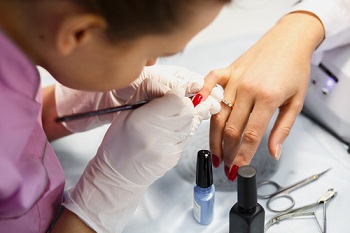Who is really paying for a $10.00 manicure?

When I see signs advertising “$10.00 manicures,” my alarm bells go off. And they should for you, too. Recent revelations of the mistreatment of manicurists in major urban centers show that nail salons keep prices as low as $10.00 by shoving the burden of their untenable business models onto the backs of an abused and impoverished workforce, comprised primarily of Asian and Latina women.
In particular, exposés of the mistreatment of New York City’s cadre of manicurists are bubbling over. On May 9, 2015, The New York Times reported on the wage exploitation, overtime violations, physical abuse, and toxic working conditions harming thousands of New York’s manicurists. FUTURES’ Esta Soler responded to this story with a Letter to the Editor, writing:
“The majority of low-wage workers are women, many of whom put up with unsafe conditions to keep their jobs or stay in abusive relationships because they lack the economic security to leave. And tipped workers, like those in nail salons, report wages so low that even with tips included they don’t come close to minimum wage.”
This morning, NBC’s Today aired a report by Ronan Farrow, where he followed sting operations conducted by the New York state investigators and revealed severe violations of minimum wage laws, rampant wage and overtime theft, and worker exposure to harmful chemicals leading to serious negative long-term health consequences.
We applaud efforts to address the wage and overtime abuses common to the nail salon industry, such as New York Governor Andrew Cuomo’s order forcing 143 nail salons to pay workers $2 million in unpaid wages and damages. However, we seek to create safe and resilient workplaces for manicurists, as well as for all low-wage and tipped workers, beyond returning stolen wages. In addition to calling for living wages for all workers, especially those who rely on tips, FUTURES’ Workplaces Respond initiative engages in collaborations to systemically improve worker conditions by helping employers create and implement policies that prevent and respond to abuses at the workplace, and provide support for low-wage workers who are particularly vulnerable to violence and exploitation.
Although these exposés focus on unfair wage practices and unsafe conditions, we believe that complete workplace safety occurs when workers have the resources they need to move towards a safer and healthier future – like a living wage, sick and safe leave, and workplace policies that prevent and provide support and resources for workers experiencing violence and exploitation, whether at home or on the job.
When I walk down the street in D.C. and see those signs in the windows, I look past the sign to see the workers. It’s clear they need more than fair wages. They need to be able to rely on their employers to provide a safe, healthy place to work. They need resources to be able to report and escape exploitation and violence.
In all industries, it’s the customers who have the greatest power to stem the tide of worker exploitation and abuse. In the case of nail salons, “$10.00 manicures” are in fact too good to be true. Customers aren’t getting a great deal; they are contributing to the exploitation of these vulnerable workers.
For the sake of the well-being of those who work so hard to help us look our best, let’s give them good service as well. We hope that advertisements like this will encourage customers to take their business elsewhere, and seek out safe nail salons that also properly compensate their workers.





